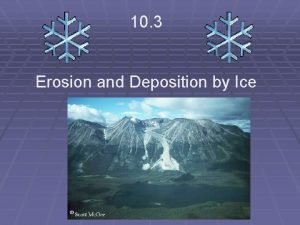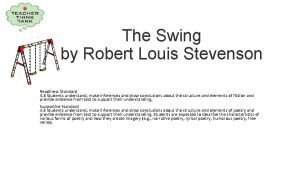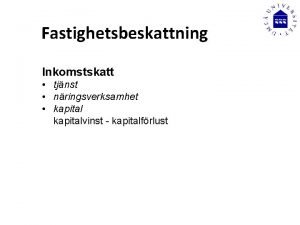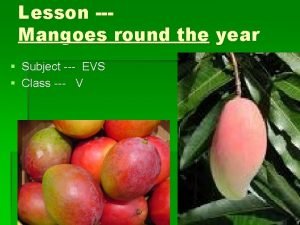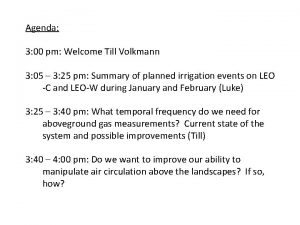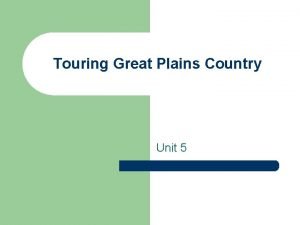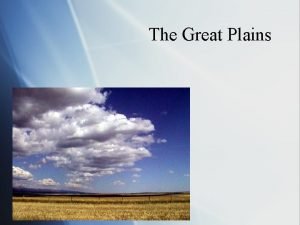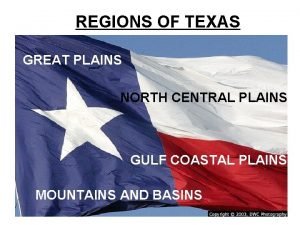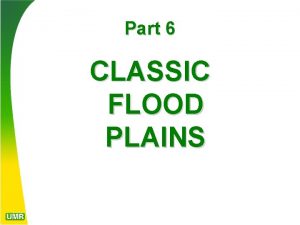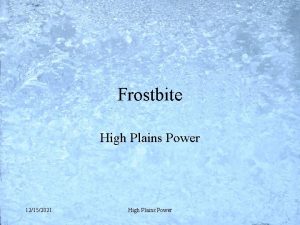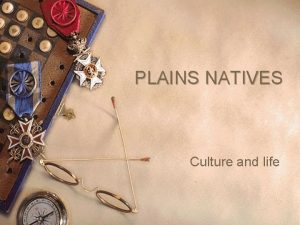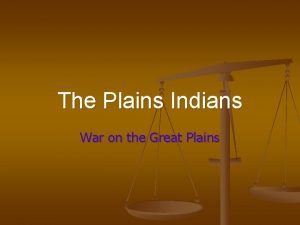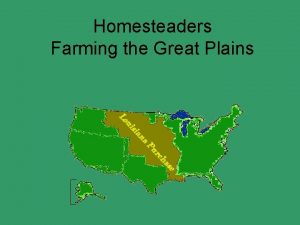Southern Till Plains Southern Till Plains This division


















































- Slides: 50




Southern Till Plains

Southern Till Plains • This division is composed of dissected Illinoian glacial till south of the Shelbyville Moraine and the Sangamon River and Macoupin Creek watersheds. Both forest and prairie were present at time of settlement. Soils are relatively poor due to clay content and frequent claypan subsoil. Post oak flatwood forest is typical of the division.

Southern Till Plains • Forest – poorly drained heavy upland soils support mostly flatwoods forest of post oak, swamp white oak, blackjack oak, and pin oak. Forests on the uplands with better drainage support black oak, shingle oak, mockernut hickory, and shagbark hickory mixed in with post oak. Forests on slopes above stream valleys are dominated by white oak, shingle oak, and black oak on drier southern and northern exposures. And hickories, white ash, basswood, sugar maple, wild black cherry, slippery elm, and black walnut among oaks are common in wetter slopes. • Floodplain forests are dominated by silver maples, willows, sycamores and American elms near the Mississippi River with pin oak, white oak, hickory, ashes, hackberry, and honey locust farther from the river.

Southern Till Plains • Prairie – accounted for about 40 % of uplands – most was mesic tall-grass prairie similar to that in the Grand Prairie Division. Alkaline slicks may have supported a unique vegetation but this is not well understood. • Marshes are found along the stream floodplains – cattail, bulrush, etc.

Post Oak – Southern Till Plains

Shingle Oak – Southern Till Plains


Wabash River Bottoms

Wabash River Bottoms • This division includes the bottomlands of the Wabash River and its major tributaries, the loess covered uplands bordering the Wabash River, and the forests of the Vermilion River, Little Vermilion, and Crab Apple Creek. This is a region of lowland oak forests containing beech, tulip tree and other trees typical of the forests to the east of Illinois. Wabash River drainage contains several distinctive fishes.

Wabash River Bottoms • Forests – Bottomland forests – pin oak, overcup oak, swamp white oak, swamp chestnut oak, bur oak, cherrybark oak, and Shumard oak. Often associated with the oaks are sweetgum, hackberry, American elm, kingnut hickory, silver maple, and pecan. Best drained terraces also have shagbark hickory, tulip tree, kingnut hickory, and Kentucky coffee tree. Along rivers are found black willows, cottonwood, sycamore, and silver maple. Sloughs support bald cypress and some other southern swamp species. • Mesic uplands support white oak, red oak, and sugar maple with some beech and tulip tree. Dry uplands have black oak and hickories.

Wabash River Bottoms • Prairies – some mesic prairies in uplands, bottomlands support mesic and wet prairies – all similar to those of the Grand Prairie. • Marshes – large areas of marsh dominated by cord grass and river bulrush

Sweet Gum – Wabash River Bottoms

River Bulrush – Wabash Border Division


Illinois Ozarks

Illinois Ozarks • This division consists of the part of the Salem Plateau of the Ozark Uplift located in Illinois – mostly from Northern Monroe County southward into the glaciated sandstone ravines in Randolph County. It has many species typical of the Ozarks, south and southwest.

Illinois Ozarks • Forest – Almost entirely forested at time of settlement. Northern forests consist of red oak, sugar maple, basswood, and Ohio buckeye on mesic sites and white oak, black oak, and hickories on ridge tops. Beech and tuliptrees occur in the mesic forests of the central section. Forests of the southern section contain many tree species including cucumber tree, blackgum, butternut, black walnut, bitternut hickory, in addition to red oak, sugar maple, basswood, white oak, black oak, Ohio buckeye, beech and tuliptree. Yellow-wood occurs in limited areas in southern section. Some shortleaf pine in the south.

Illinois Ozarks • Prairie – loess hill prairies are found on top of the river bluffs. Similar to the loess hill prairies of the Middle Mississippi Border Division with little bluestem and sideoats grama dominating.

Ohio Buckeye – Ozark Division

Blackgum – Ozark Division


Lower Mississippi Bottomland Forests

Lower Mississippi Bottomland Forests • This division includes areas near the Mississippi River and its floodplain from Alton to the Thebes Gorge. Mississippi is very muddy here due to silt load from the Missouri. Northern part had prairie, marsh and forest. Southern part was densely forested.

Lower Mississippi Bottomland Forests • Forests – Northern section mostly forested at time of settlement. Light soils supported silver maple, ashes, American elm, honey locust, sugarberry, and pecan. Beech, basswood, and red buckeye also found on loamy soils. Southern section bottomland forests supported pin oak, overcup oak, Shumard oak, cherrybark oak, along with kingnut hickory, sugarberry, and sweetgum. Swamps supported pumpkin ash, swamp cottonwood, Drummond’s red maple, and water locust. Bald cypress occur as far north as Union County.

Lower Mississippi Bottomland Forests • Prairie – relatively large areas of wet and mesic prairie in the northern section but most have been drained for agriculture. They were similar to wet and mesic prairies of the Grand Prairie. • Marsh – northern section had large marshes dominated by river bulrush, cattail, lotus, and pickerelweed. Some marshes remain.

Overcup Oak – Bottomland Forests

Pickerelweed – Lower Mississippi River Bottomlands


Shawnee Hills

Shawnee Hills • The Shawnee Hills extend across the southern tip of the state from Fountain Bluff on the Mississippi River to the Shawneetown Hills near the mouth of the Wabash River. This unglaciated hill country is characterized by a high east -west escarpment of sandstone cliffs forming the Greater Shawnee Hills and a series of lower hills underlain by limestone and sandstone known as the Lesser Shawnee Hills. This was mostly forested and much of that forest remains today. Many distinctive plants are restricted to this division of Illinois.

Shawnee Hills • Forests – Much timber is still present. Upland forests are dominated by white oak, black oak, and shagbark hickory with post oak, blackjack oak, scarlet oak, and pignut hickory on dry sites. Deep mesic ravines have red oak, beech, tuliptree, bitternut hickory, sugar maple, and white ash, with some black walnut, butternut, Ohio buckeye, and basswood. • Floodplain forests also contain sycamore, Kentucky coffeetree, sugar berry, and honey locust.

Shawnee Hills • Prairie – Limestone glades in lesser Shawnee Hills support dry prairie like those of hill prairies in western Illinois but with addition of southern plants like wild blue sage and heart-leaved tragia.

Shawnee Hills • Distinctive plants – filmy fern, Virginia saxifrage, small-flowered rock-pink, thread-leaved evening primrose, synandra, French’s shooting star, and small-flowered alumroot.

Shawnee Hills


Shawnee Hills – Limestone Glade

Limestone Glade • Glades differ from hill prairies in having exposed bedrock which is usually limestone but may be sandstone. They often support a variety of mosses and lichens. Western succulents like prickly pear and sedum are common. In the spring there can be showy displays of purple coneflower, New Jersey Tea, and wild hyacinth. Blackjack oak and red cedar may be common. Unusual animals present include the lichen grasshopper and olive hairstreak butterfly.

Tulip Tree – Shawnee Hills

Thread-leaved Evening Primrose Shawnee Hills


Coastal Plain at Cairo

Coastal Plain Division • This is a region of swampy forested bottomlands and low clay and gravel hills that is the northernmost extension of the Gulf Coastal Plain Province in North America. Bald cypress-tupelo gum swamps are unique in Illinois and many southern animals and plants are found here. It has a relatively mild climate and is the warmest region in the state.

Coastal Plain Division • Forest – Mostly forested prior to settlement. Upland forests like those of Shawnee Hills – mostly black oak, white oak, red oak, cherrybark oak, blackgum, tulip tree, shagbark hickory, and pignut hickory, also some beech, cucumber tree, and native chestnuts. • Bottomland forests – Shumard oak, cherrybark oak, swamp white oak, swamp chestnut oak, pin oak, overcup oak, kingnut hickory, shagbark hickory, bitternut hickory, ashes, sweetgum, blackgum, honey locust, sugarberry, pecan, wild black cherry, and catalpa. Silver maple and American elm grow along streams.

Coastal Plain Division • Bottomland swamps – bald cypress, tupelo gum, swamp cottonwood, Drummond’s red maple, water locust, pumpkin ash, and overcup oak. Some water hickory and planer-tree too.

Coastal Plain Division • Prairies – some prairies occurred on dry and mesic upland hills. Dry prairies were dominated by little bluestem. Mesic prairies were dominated by big bluestem, Indian grass, and grama grass. • Southern seep spring bog – Some seep springs in the eastern hills are very acidic and support sedges, royal fern, lady fern, and cinnamon fern. May contain large areas of sphagnum moss. Have many southeastern species like netted chain fern, screw-stem, and incomperta sedge.

Bald Cypress – Coastal Plain Division

Netted Chain Fern – Coastal Plain Division
 God be with you till we meet again images
God be with you till we meet again images Great plains ultra till
Great plains ultra till Central plains center of amarillo, tx
Central plains center of amarillo, tx Southern plains regional office
Southern plains regional office Synthetic division
Synthetic division Short division vs long division
Short division vs long division Synthetic division of polynomials
Synthetic division of polynomials Hcf method
Hcf method Sekundära agenter
Sekundära agenter What are the two main types of glaciers
What are the two main types of glaciers Alternativ till bredsida
Alternativ till bredsida سيرور دي كوير
سيرور دي كوير Introduktion till vetenskapsteorin
Introduktion till vetenskapsteorin Inledning informerande tal
Inledning informerande tal Till the end of my days
Till the end of my days Upphöjt till en halv
Upphöjt till en halv Frsta
Frsta Från malm till metall
Från malm till metall Till i can see so wide
Till i can see so wide Vad är orsaker till första världskriget
Vad är orsaker till första världskriget Lngd
Lngd Tredimensionellt fastighetsutrymme
Tredimensionellt fastighetsutrymme Buddhismen levnadsregler
Buddhismen levnadsregler Syndrome de wolkman
Syndrome de wolkman Prime numbers 101-200
Prime numbers 101-200 From the rising of the sun till it's going down
From the rising of the sun till it's going down Skriva ett formellt brev
Skriva ett formellt brev Bryants store money mississippi
Bryants store money mississippi Food items would not spoil till one month
Food items would not spoil till one month Vishnuiter
Vishnuiter Dolkstötslegenden
Dolkstötslegenden Kubikdecimeter till kubikmeter
Kubikdecimeter till kubikmeter Till volkmann
Till volkmann Neptunus fakta
Neptunus fakta Från student till docent
Från student till docent Till we meet again vera lynn
Till we meet again vera lynn Matens väg från munnen till ändtarmen
Matens väg från munnen till ändtarmen Grekisk mytologi medusa
Grekisk mytologi medusa Guide solceller till bostadsrättsföreningen
Guide solceller till bostadsrättsföreningen Andra världskriget bakgrund
Andra världskriget bakgrund Kubikcentimeter till kubikmeter
Kubikcentimeter till kubikmeter Till schreiber
Till schreiber Roligt tal till student
Roligt tal till student Match the rhyming words
Match the rhyming words Källhänvisa till hemsida
Källhänvisa till hemsida Not till the loom is silent
Not till the loom is silent The murder of emmitt till date
The murder of emmitt till date Abrahams släktträd religion
Abrahams släktträd religion En tråd som är 48 cm lång böjs till en rektangel
En tråd som är 48 cm lång böjs till en rektangel Parameterform till normalform
Parameterform till normalform Don't put till tomorrow what you can do today
Don't put till tomorrow what you can do today









